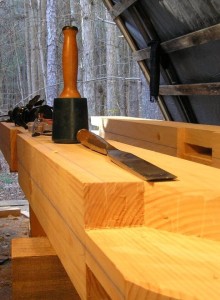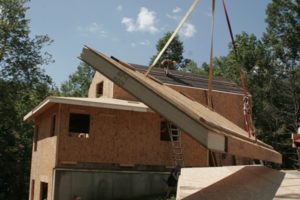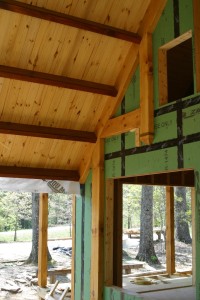 When builders and architects say “timber frame” what they mean is that the structure of an entire building or maybe just a portion of it is supported primarily by large wooden timbers that are joined with pegs or by other types of decorative joinery. Almost always, the walls of the structure are on the outside of the timber frame leaving the timbers exposed for visual effect.
When builders and architects say “timber frame” what they mean is that the structure of an entire building or maybe just a portion of it is supported primarily by large wooden timbers that are joined with pegs or by other types of decorative joinery. Almost always, the walls of the structure are on the outside of the timber frame leaving the timbers exposed for visual effect.
Timber frames are often confused with, but are quite different from log-homes. Timber framing is an age-old building process, and the basics have not changed much over the centuries. However, technology has made the process easier, ensuring the builder more sound structures that have increased levels of efficiency and comfort. Hybrid buildings can now include both conventional and timber frame elements, which may be beneficial in some instances.
What are the Benefits?
Beyond the aesthetics of exposed timber and open floor plans, timber frame structures enjoy a durability unmatched by conventionally-built homes. They also provide more structural integrity in the unfortunate event of fire damage, as the large timber supports are more resistant to burning completely through than the thinner cuts of wood that make up conventional building structures. Finally, a timber frame home affords the owner opportunities to use bold design statements, as timbers come in an untold number of sizes, shapes and colors.
Timber Frame Lingo
Like most specialized art forms, timber framing has a language all its own, with terms for the various tools, processes and codes. Below is a brief list of commonly-used timber frame terms to help you better understand the process..
Timbers – the wooden beams that comprise the home’s structural frame

Kit – timber frame kits or post and beam kits are pre-fabricated home plans and materials that come together quickly and easily. However, they can limit your options greatly and typically do not provide the same level of quality as custom timber frame buildings.
SIPs – structurally insulated panels, these building pieces sheath the structure. Made of two layers of durable flat wood and filled with a highly dense insulating foam in between, SIPs have more or less revolutionized the timber frame building process.
Hybrid – this type of building combines the methods of timber framing and conventional stud frame building. Depending on the home’s location, climate and budget, a hybrid building may or may not provide the homeowner benefits.

Braces – an element of a joint that fortifies the frame by resisting movement in a certain direction. Knee braces are a popular type of brace, as they incorporate very natural-looking ‘knee’ timber piece.
Crossbeams – these connect the post beams, providing stability
Joints – where two timbers or frame pieces come together. Joints can range from simple to highly decorative and include lap joints, mortise-and-tenon joints, dovetailed and pegged joints, among many others. Your designer can show you samples of each type of joint.
Truss – a rigid triangle of timbers, trusses provide column-free floor space, are typically incorporated on the top floor.
Love the photos!!!!
Thanks Greg.